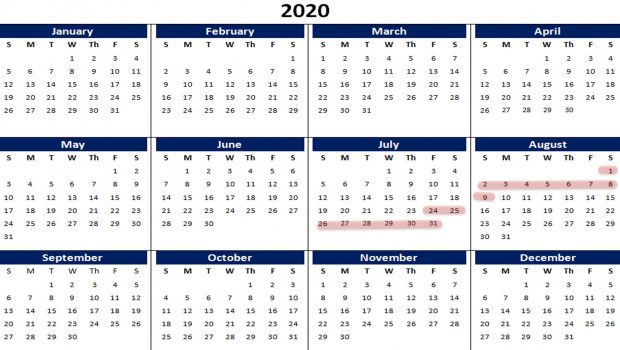Tokyo 2020: Hot by choice
Published on October 24th, 2019
While the distractions for the Rio 2016 Olympics were crime, pollution, and the threat of Zika virus, the Tokyo 2020 Olympics have narrowed it down to heat and humidity. However, that’s what happens when you host the event during the time of year with the greatest heat and humidity. In this report by David Owen, he explains why this is:
The real question is: why are the Games returning to Tokyo at such a debilitatingly hot time of year (July 24, 2020 – August 9, 2020)? In 1964, after all, the Olympics took place entirely in October, though a similar window today would leave them at risk of disruption from typhoons.
The Tokyo 1940 Games would have run from September 21 to October 6; that would perhaps be somewhere close to the ideal option, though a longer gap than usual between the Olympics and Paralympics might have to be contemplated to keep the latter away from typhoon season.
In his recent speech to the Association of National Olympic Committees (ANOC) General Assembly in Doha, which I thought interesting on two or three levels, I noticed that International Olympic Committee (IOC) President Thomas Bach made a reference to “increasing temperatures there in Japan over the last couple of years”.
He is right: things have taken a turn for the worse. Analyzing data covering the exact 17-day Tokyo 2020 Games period over the last decade, the hottest maximum temperatures for 12 of those 17 days have been registered in 2018 or 2019.
However, sweltering summers in the Japanese capital are hardly a new phenomenon.
In 2013 – the year Tokyo was chosen to host the Games – for example, the mercury hit 30ºC or more on 11 of the 17 days between July 24 and August 9, rising to a maximum of 33ºC.
Humidity in 2013, moreover, was below 75 per cent for only two of the 17 days; on five days, it was above 85 per cent.
The plain fact is that while Summer Games were staged in September or later in 1956, 1964, 1988, and 2000, every timetable set since then – that is seven editions up to and including Los Angeles 2028 – has situated the event in the six weeks between July 20 and August 31.
This, seemingly, has become, in relatively recent times, the all but immovable Summer Games window.
And since the Olympic Charter is crystal clear in stating that “the dates of the Olympic Games are determined by the IOC Executive Board,” I think that august body (pun possibly intended) should explain to athletes, fans, and the whole gamut of those who attend the Olympics to work out how and why this has come about.
I think I have a bit of an idea, and much as the leadership like to talk about principles and values, the reality is that most decisions taken by a body as diverse and consequential as the IOC are likely to be the result of trade-offs and compromises of one kind or another.
Perhaps the value judgements that have resulted in Summer Olympic-time becoming, apparently, so much more rigidly delineated in the 21st century than it was in the 20th, might be deemed justified.
But I doubt I am alone in wanting to hear more about the decision-making process.
Former IOC President Jacques Rogge once told me that a proposal by Doha 2020 to stage the Games in September and October “would be accepted,” subject to IOC conclusions regarding a supplementary report on “the temperature issue.”
However, the bid was subsequently axed after a Working Group report said the Qatari city would need to “construct and test the substantial amount of new infrastructure needed” to host the Games.
If global warming continues at its present rate, it is hard to imagine in any case that we will not revert, sooner rather than later, to a situation in which Summer Olympics are sometimes staged in the northern-hemisphere autumn or even spring.
After all, after much kerfuffle, we are on course in three years for a winter FIFA World Cup.
Talking of football, the recently released 2019 FIFA Women’s World Cup viewing figures make plain that the old-fashioned in-home telly has well and truly lost its grip on our sports-watching habits.
While 993.5 million watched a minute or more of the tournament on their TVs, an estimated 481.5 million did so on digital platforms. That is considered well over five times as many as four years ago.
Of the 263.6 million who watched a minute or more of the final, almost a third – 85.5 million – were out-of-home or digital-only viewers.
More than half – 58 per cent – of the competition’s digital viewers were based in a single country; yes, China.
With China set to host major upcoming events such as the 2022 Winter Olympics and Paralympics and, seemingly, the 2021 FIFA Club World Cup, you have to think it will not be long before some big televised set-piece sports occasions find themselves with more digital viewers than TV-watchers.
Editor’s note: As the IOC benefits from the significant fees paid by NBC Television, it would stand to reason that NBC wants the Olympics during a time of year in the USA which lacks competition. That time of year is July-August as prominent shows are on re-runs and only baseball is being played.









 We’ll keep your information safe.
We’ll keep your information safe.